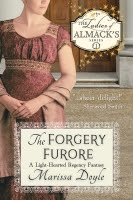Well, it very much depended on when and where you were.
 If you were sending, say, a note of invitation to a friend who lived in the same town, the simplest way to get it to her would be to have a servant or family member deliver it. Footmen often served as messengers (and I’m sure appreciated a chance to step out of the house!)
If you were sending, say, a note of invitation to a friend who lived in the same town, the simplest way to get it to her would be to have a servant or family member deliver it. Footmen often served as messengers (and I’m sure appreciated a chance to step out of the house!)If however, you didn’t have servants to deliver notes, what did you do? If you were in London, you were in luck: a postal system for the city came into being during the late seventeenth century, and through 1801 it cost a penny to send a letter (and with four to eight pick-ups and deliveries a day, it was speedy as well). Mail coaches started traveling scheduled routes in 1794, but by 1805 the price of delivery in London had risen to 2 pennies, and by 1812 a fee system based on distance was in place: fourpence for delivery within fifteen miles, rising to 17 pence for 700 miles. Charges doubled for more than one sheet of paper, which was why cross-writing letters was such a popular practice. And lastly, it was the recipient of the letter who paid the postage upon delivery, not the sender—so it was very important to consider to whom you were writing, and whether they could afford to hear from you!
 Now, if you were lucky and had a good friend or family member who was a Member of Parliament or a peer, you could get him to “frank” your letter—sign his name and write his address on the outside of the letter—and it would be delivered free of charge. We still see this today in the US in items mailed by congressmen.
Now, if you were lucky and had a good friend or family member who was a Member of Parliament or a peer, you could get him to “frank” your letter—sign his name and write his address on the outside of the letter—and it would be delivered free of charge. We still see this today in the US in items mailed by congressmen. In 1837, Sir Rowland Hill (not to be confused with the Waterloo general Lord Rowland Hill) sponsored a parliamentary bill to reform the postal system: his recommendations included the use of envelopes and pre-payment of postage. An adhesive stamp affixed to letters was eventually agreed upon as the best method of proof that postage had been paid, and in May 1840 the “Penny Black”, the first postage stamp, was introduced. It featured the young Queen Victoria's profile, as you can see here.
In 1837, Sir Rowland Hill (not to be confused with the Waterloo general Lord Rowland Hill) sponsored a parliamentary bill to reform the postal system: his recommendations included the use of envelopes and pre-payment of postage. An adhesive stamp affixed to letters was eventually agreed upon as the best method of proof that postage had been paid, and in May 1840 the “Penny Black”, the first postage stamp, was introduced. It featured the young Queen Victoria's profile, as you can see here.The establishment of the penny post had a direct bearing on the establishment of another custom: Christmas cards. In 1843 Sir Henry Cole (who later became the first director of the Victoria and Albert Museum, which is one of my favorite places in London) decided he didn’t have time to write all the Christmas greeting letters that it was customary to exchange and hired artist and printer John Horseley to design an illustrated card that he could send instead. A thousand or so copies were printed, and what Sir Henry didn’t use, Horseley sold for a shilling each. This was a tad pricey, but the idea caught on the following year when a rival printer, W.C.T. Dobson, printed and sold his own Christmas cards, which sold reasonably well thanks to the fact that it cost only a penny to mail them. By 1862, large scale production of Christmas cards was underway.
And on a completely unrelated note, this is our 250th post!
Next Tuesday: The Young Bluestockings Book Club will discuss Mairelon the Magician by Patricia C. Wrede. See you there!





1 comment:
That's so interesting how the Christmas card developed out of the postage system. I wish we had 6-8 mail deliveries a day! We're lucky we still have 1.
I've been looking at some Civil War letters and many still have their envelopes complete with stamps!
Post a Comment